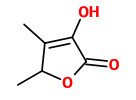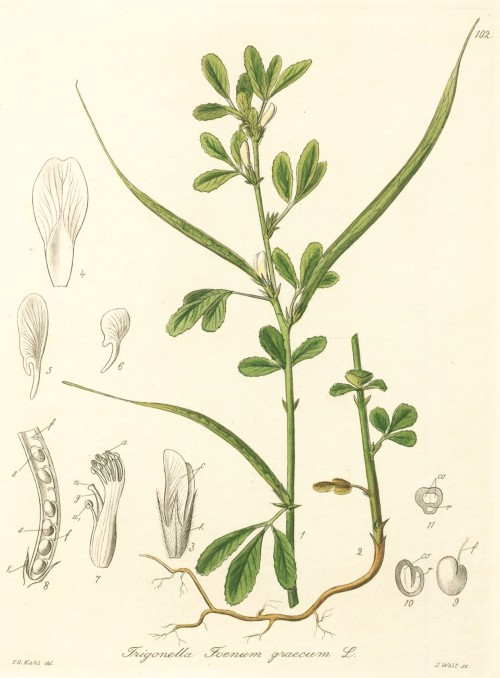Dies ist eine alte Version des Dokuments!
Trigonella foenum-graecum L. - Fabaceae - fenugreek, greek clover, greek hay, Bockshornklee, Griechischer Bockshornklee, Griechisches Heu
Taprooted annual herb, 30-60cm high, native to Asia and the Mediterranean region; axillary flowers solitary or in pairs, cream to pale yellow; pods linear, up to 10cm long, with up to 20 seeds; seeds rhomboid;
„The specific epithet foenum graecum means Greek hay.“ http://de.wikipedia.org/wiki/Trigonella_foenum-graecum
„It is cultivated worldwide as a semi-arid crop, and its seeds are a common ingredient in dishes from the Indian Subcontinent…. charred fenugreek seeds have been recovered from Tell Halal, Iraq, (carbon dated to 4000 BC) and Bronze Age levels of Lachish and desiccated seeds from the tomb of Tutankhamen.“ http://en.wikipedia.org/wiki/Fenugreek
Traditionally used as digestive tonic, demulcent, expectorant. „The characteristic foenugreek smell is ascribed to 3-hydroxy-4,5-dimethyl-2[5H]-furanone (sotolon); the bitter taste to the furostanol glycosides.“ [MPW]
 3-hydroxy-4,5-dimethyl-2[5H]-furanone (sotolon)
3-hydroxy-4,5-dimethyl-2[5H]-furanone (sotolon)
Fenugreek is the source of the sotolone present in curry powder. „Furthermore, it is interesting to note that sotolone seems to be relatively stable in the seed, since the sample from Egypt (25mg/kg) was already seven years old.“ [Blank, I.; Schieberle, P.; Grosch, W. Quantification of the flavour compounds 3-hydroxy-4,5-dimethyl-2(5H)-furanone and 5-ethyl-3-hydroxy-4-methyl-2(5H)-furanone by a stable isotope dilution assay. In Progress in Flavour and Precursor Studies; Schreier, P.; Winterhalter, P., Eds.; Allur. Publ.: Wheaton, USA, 1993, pp. 103-109] http://www.imreblank.ch/Bioflavour_1993_103.pdf
An aroma extract dilution analysis (AEDA) was applied to classify the aroma composition of T.foenum-graecum extract into three groups having different sensory relevance:
“high” - sotolon (seasoning-like)
“medium” - (Z)-1,5-octadiene-3-on (metallic), acetic acid (acid), and 3-amino-4,5-dimethyl-3,4-dihydro-2(5H)-furanon (seasoning-like)
“background” - diacetyl (buttery), 1-octene-3-one (mushroom), 3-isopropyl-2-methoxypyrazine (roasty-earthy), 3-isobutyl-2-methoxypyrazine (roasty-paprikalike), linalool (flowery), butenoic acid (sweaty-rancid), isovaleric acid (sweaty-rancid), caproic acid (musty) and eugenol (spicy)
(together with some unidentified substances).
[Blank, I., Lin, J., Devaud, S., Fumeaux, R., & Fay, L. B. (1997, January). The principal flavor components of fenugreek (Trigonella foenum-graecum L.). In ACS Symposium Series (Vol. 660, No. 3, pp. 12-28). Washington, DC: American Chemical Society,[1974]] http://www.imreblank.ch/ACS_1997_660_12.pdf
„The average yield in essential oil was 1.24% (w/w). GC-MS analysis resulted in the identification of 13 compounds representing 97.2% of the total essential oil. The most abundant components (> 4%) of the fenugreek essential oil were β-pinene (15.05%), 2,5-dimethylpyrazine (6.14%), 6-methyl-5-hepten-2-one (4.48%), camphor (16.32%), 3-octen-2-one (4.32%), β-caryophyllene (14.63%), neryl acetate (17.32%), α-selinene (4.04%) and geranial (4.81%).“
[Inhibitory potential of omega-3 fatty and fenugreek essential oil on key enzymes of carbohydrate-digestion and hypertension in diabetes rats. Hamden, K., Keskes, H., Belhaj, S., Mnafgui, K., Allouche, N., Lipids in health and disease, Vol.10(1), 2011, 226] http://www.lipidworld.com/content/10/1/226/

Kohl, F.G., Die officinellen Pflanzen der Pharmacopoea Germanica, t. 102 (1891-1895) [F.G. Kohl]
http://plantgenera.org/species.php?id_species=1032679
